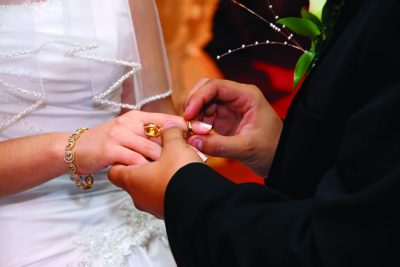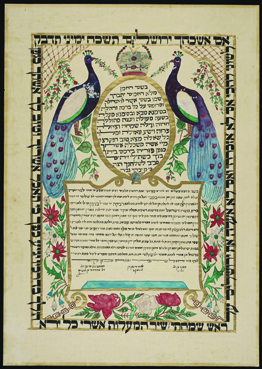×


We have detected your country as:
Please click here to go to the USA website or select another country from the dropdown list.
by: Kathy DeGagne, BFP Staff Writer
To life, l’chaim, l’chaim,
L’chaim, l’chaim, to life,
It takes a wedding to make us say,
“Let’s live another day,”
Drink l’chaim, to life!
“To Life!” is a song from the quintessential Jewish musical “Fiddler on the Roof,” where the people of Anatevka rejoice over the upcoming wedding of Tevye’s daughter. From time immemorial, weddings have been times of rejoicing and celebration.
What is it about a wedding that fills us with such joy? To Tevya and his Jewish neighbors facing poverty and pogroms in early 20th-century Russia, a wedding spoke of the renewal of life in the midst of hardship. It was the promise of better things to come.
In Israel today, a wedding continues to represent those same things to a people who face terror on a daily basis—and who can still look to the future with hope. It’s a joyful expression of Am Yisrael Chai—the people of Israel live! (See page 12–13: “Living Out Loud in the Face of Terror”).
A Jewish wedding is inextricably linked to the history of the Jewish people. The ceremony is a picture of the marriage between God and the Jewish people on Mount Sinai. Throughout the Tanakh (Gen.–Mal.) God speaks words of covenant to His bride: “I will betroth you to Me forever; yes, I will betroth you to Me in righteousness and justice, in lovingkindness and mercy …” (Hosea 2:19). The Torah (Gen.–Deut.) is the Book of the Covenant where God’s faithful marriage covenant with His people has secured their survival for millennia, while their oppressors have disappeared into the sands of time.
Like Yom Kippur, the wedding day is a private day of reflection and repentance for the bride (kallah) and groom (chatan). They clothe themselves in white symbolizing purity and sanctity; and both fast until after the marriage ceremony to prepare themselves for the most important day of their lives.

sunshineinlove/shutterstock.com
In religious weddings, the bride and groom don’t see one another for one week before the marriage; so on the day of the wedding each one receives their guests separately (Kabbalat Panim). The bride sits on a “throne” in one room, and the groom gathers his “courtiers” around him in another. Afterwards the groom places a veil over the bride’s face, signifying that the beauty of her appearance is secondary to the beauty of her heart. The veil is a promise that the groom will clothe and protect his wife, and she will live a life of modesty. This tradition (Badeken) comes from Genesis 24:65 where Rebekah veils her face before meeting Isaac.
A chuppah is a wedding canopy open on all sides demonstrating that the couple’s home will be a place of hospitality under God’s protection. The couple is escorted to the chuppah by their parents; then the bride circles the groom seven times. The seven circuits symbolize completion and wholeness and the establishment of the couple’s new life together. In Ashkenazi tradition, the chuppah is outside under the stars, referring to the covenant between God and Abraham when He told him that his descendants would be as numerous as the stars in the night sky (Gen. 15:5).
After the rabbi recites a blessing over the couple, they drink from a cup of wine. Wine symbolizes joy and is connected to Kiddush, the Shabbat prayer of sanctification. The first part of the ceremony is called Kiddushim (the betrothal), the sanctification of the bride and groom to one another. The second part of the ceremony is called Nisu’im and refers to the actual marriage.

york777/shutterstock.com
The marriage is legally binding once the groom gives the bride a ring and declares, “Behold, you are betrothed unto me with this ring, according to the law of Moses and Israel!” Then he slips the ring onto the forefinger of her right hand. At this point in the ceremony, the couple is now fully married.
The ketubah is a beautifully designed work of art inscribed with the terms of the marriage contract. It is read out loud in Aramaic and signed by two witnesses. The ketubah is a legally binding contract that protects the bride’s rights as a wife, ensuring that her husband will always provide for her physical and emotional needs.

wikipedia.org
Seven blessings are read over the couple uniting them to faith in God, Creator and Redeemer of the Jewish people. The couple drinks from a cup of wine again and the glass is then placed in a cloth napkin on the ground. The groom shatters it under his foot to commemorate the destruction of the Temple in Jerusalem. At the moment of their greatest joy, the couple is reminded to exalt Jerusalem even above their own wedding day (Ps. 137:6).
The ceremony is now concluded and the couple and their guests retire to the wedding hall to eat and celebrate. Everyone participates in expressing the joy of the occasion by dancing in “free dance.” Large circles form and all join in to dance for joy, with no set steps or choreography.
As we conclude our guide to a Jewish wedding, there may be no more fitting way to end than praying the Seventh Blessing of the marriage ceremony: “O God, may there always be heard in the cities of Israel and in the streets of Jerusalem: the sounds of joy and happiness, the voice of loving couples, the shouts of young people celebrating, and the songs of children at play.”
All logos and trademarks in this site are property of their respective owner. All other materials are property of Bridges for Peace. Copyright © 2024.
Website Site Design by J-Town Internet Services Ltd. - Based in Jerusalem and Serving the World.